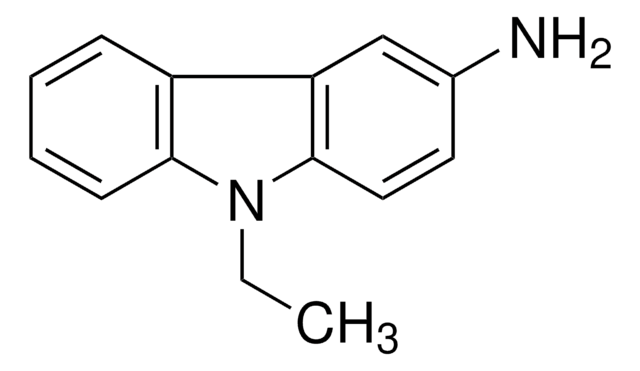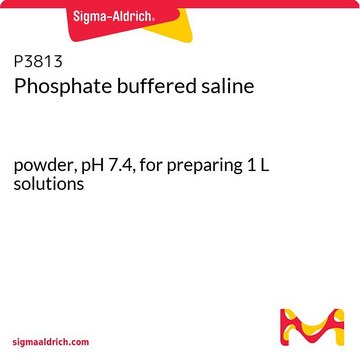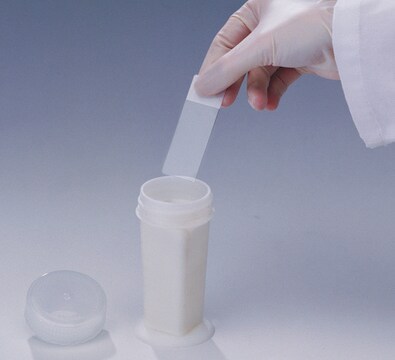AEC101
AEC Staining Kit
liquid
Synonyme(s) :
ACE substrate kit
Se connecterpour consulter vos tarifs contractuels et ceux de votre entreprise/organisme
About This Item
Code UNSPSC :
41116134
Nomenclature NACRES :
NA.32
Produits recommandés
Forme
liquid
Utilisation
sufficient for ≥1,000 tests (150 ml substrate solution)
Température de stockage
2-8°C
Application
AEC Staining Kit has been used as a substrate
- for developing the extravidin peroxidase antibody in cell-seeded matrice sections using histology and immunohistochemistry methods
- for streptavidin-horseradish peroxidase in peripheral blood mononuclear cells in ex vivo enzyme-linked immunospot (ELISPOT) assay
- for mouse IgG biotinylated secondary antibody in immunohistostaining of epididymal fat pads
Conditionnement
Kit contains 3 mL of concentrated acetate buffer, 3-amino-9-ethylcarbazole (AEC) chromogen and hydrogen peroxide in a dropper bottle for easy dispensing. Directions for use with each application are included.
Attention
Stable at least one year at 2-8 °C.
Produit(s) apparenté(s)
Réf. du produit
Description
Tarif
Mention d'avertissement
Danger
Mentions de danger
Classification des risques
Acute Tox. 4 Dermal - Acute Tox. 4 Inhalation - Carc. 1B - Eye Irrit. 2 - Flam. Liq. 3 - Repr. 1B
Code de la classe de stockage
3 - Flammable liquids
Classe de danger pour l'eau (WGK)
WGK 3
Point d'éclair (°F)
134.6 °F - closed cup
Point d'éclair (°C)
57 °C - closed cup
Faites votre choix parmi les versions les plus récentes :
Déjà en possession de ce produit ?
Retrouvez la documentation relative aux produits que vous avez récemment achetés dans la Bibliothèque de documents.
Les clients ont également consulté
Nicolas Gaudenzio et al.
The Journal of allergy and clinical immunology, 131(5), 1400-1407 (2013-03-23)
Mast cells are key components of the skin microenvironment in psoriasis, yet their functional role in this T-cell-mediated inflammatory disorder remains to be elucidated. To define the impact of T-cell/mast-cell cognate interactions on the cytokines produced by TH cells. We
Kaiyuan Ni et al.
Nature communications, 9(1), 2351-2351 (2018-06-17)
Checkpoint blockade immunotherapy enhances systemic antitumor immune response by targeting T cell inhibitory pathways; however, inadequate T cell infiltration has limited its anticancer efficacy. Radiotherapy (RT) has local immunomodulatory effects that can alter the microenvironment of irradiated tumors to synergize
Leslie R Morse et al.
Translational stroke research, 2(4), 643-650 (2012-03-01)
Spinal cord injury is associated with rapid bone loss and arrested long bone growth due to mechanisms that are poorly understood. In this study, we sought to determine the effects of severe T10 contusion spinal cord injury on the sublesional
Kuangda Lu et al.
Journal of the American Chemical Society, 138(38), 12502-12510 (2016-08-31)
Photodynamic therapy (PDT) can destroy local tumors and minimize normal tissue damage, but is ineffective at eliminating metastases. Checkpoint blockade immunotherapy has enjoyed recent success in the clinic, but only elicits limited rates of systemic antitumor response for most cancers
Identification of early secretory antigen target-6 epitopes for the immunodiagnosis of active tuberculosis
Vincenti D, et al.
Molecular Medicine, 9(3), 105-105 (2003)
Notre équipe de scientifiques dispose d'une expérience dans tous les secteurs de la recherche, notamment en sciences de la vie, science des matériaux, synthèse chimique, chromatographie, analyse et dans de nombreux autres domaines..
Contacter notre Service technique












